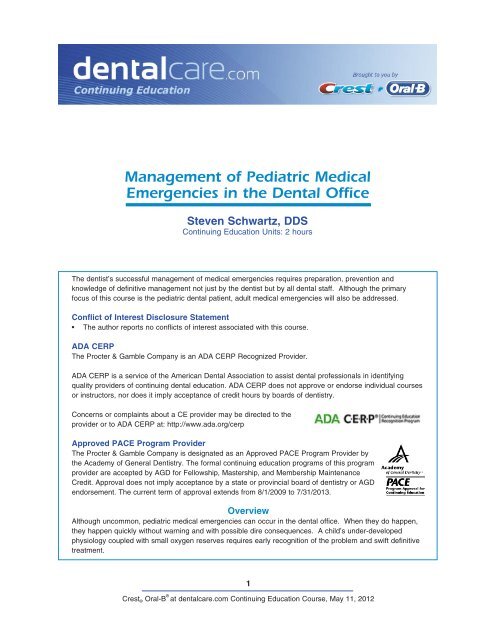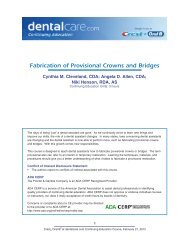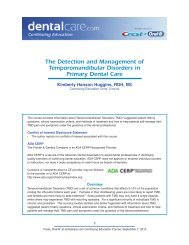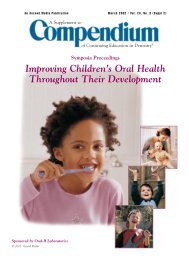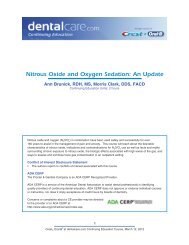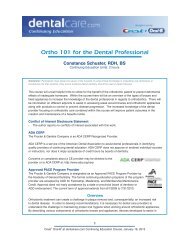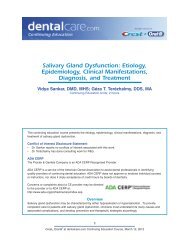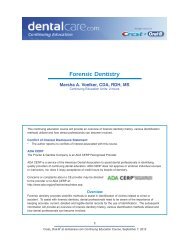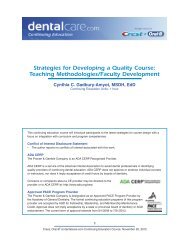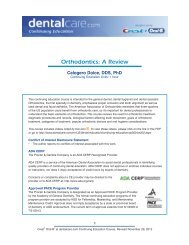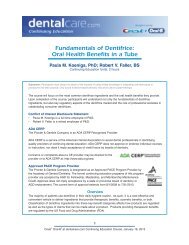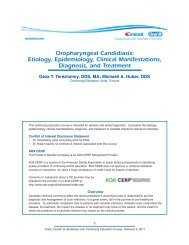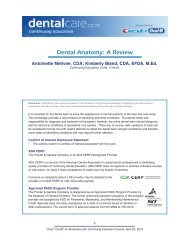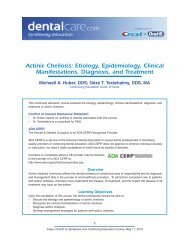CE 391 - Management of Pediatric Medical ... - DentalCare.com
CE 391 - Management of Pediatric Medical ... - DentalCare.com
CE 391 - Management of Pediatric Medical ... - DentalCare.com
Create successful ePaper yourself
Turn your PDF publications into a flip-book with our unique Google optimized e-Paper software.
<strong>Management</strong> <strong>of</strong> <strong>Pediatric</strong> <strong>Medical</strong><br />
Emergencies in the Dental Office<br />
Steven Schwartz, DDS<br />
Continuing Education Units: 2 hours<br />
The dentist’s successful management <strong>of</strong> medical emergencies requires preparation, prevention and<br />
knowledge <strong>of</strong> definitive management not just by the dentist but by all dental staff. Although the primary<br />
focus <strong>of</strong> this course is the pediatric dental patient, adult medical emergencies will also be addressed.<br />
Conflict <strong>of</strong> Interest Disclosure Statement<br />
• The author reports no conflicts <strong>of</strong> interest associated with this course.<br />
ADA <strong>CE</strong>RP<br />
The Procter & Gamble Company is an ADA <strong>CE</strong>RP Recognized Provider.<br />
ADA <strong>CE</strong>RP is a service <strong>of</strong> the American Dental Association to assist dental pr<strong>of</strong>essionals in identifying<br />
quality providers <strong>of</strong> continuing dental education. ADA <strong>CE</strong>RP does not approve or endorse individual courses<br />
or instructors, nor does it imply acceptance <strong>of</strong> credit hours by boards <strong>of</strong> dentistry.<br />
Concerns or <strong>com</strong>plaints about a <strong>CE</strong> provider may be directed to the<br />
provider or to ADA <strong>CE</strong>RP at: http://www.ada.org/cerp<br />
Approved PA<strong>CE</strong> Program Provider<br />
The Procter & Gamble Company is designated as an Approved PA<strong>CE</strong> Program Provider by<br />
the Academy <strong>of</strong> General Dentistry. The formal continuing education programs <strong>of</strong> this program<br />
provider are accepted by AGD for Fellowship, Mastership, and Membership Maintenance<br />
Credit. Approval does not imply acceptance by a state or provincial board <strong>of</strong> dentistry or AGD<br />
endorsement. The current term <strong>of</strong> approval extends from 8/1/2009 to 7/31/2013.<br />
Overview<br />
Although un<strong>com</strong>mon, pediatric medical emergencies can occur in the dental <strong>of</strong>fice. When they do happen,<br />
they happen quickly without warning and with possible dire consequences. A child’s under-developed<br />
physiology coupled with small oxygen reserves requires early recognition <strong>of</strong> the problem and swift definitive<br />
treatment.<br />
1<br />
Crest ® Oral-B ®<br />
at dentalcare.<strong>com</strong> Continuing Education Course, May 11, 2012
Since adults ac<strong>com</strong>pany the pediatric patient to the dental <strong>of</strong>fice there is a strong possibility, although the<br />
child is the one receiving dental treatment, it’s the ac<strong>com</strong>panying adult that presents with the emergency.<br />
Although the primary focus <strong>of</strong> this course is the pediatric dental patient, adult medical emergencies will also<br />
be addressed.<br />
The dentist’s successful management <strong>of</strong> medical emergencies requires preparation, prevention and<br />
knowledge <strong>of</strong> definitive management not just by the dentist but by all dental staff.<br />
Learning Objectives<br />
Upon <strong>com</strong>pletion <strong>of</strong> this course, the dental pr<strong>of</strong>essional should be able to:<br />
• Identify predisposing factors for medical emergencies<br />
• Structure an effective <strong>of</strong>fice medical emergency team<br />
• Choose the appropriate emergency drug kit and equipment<br />
• Recognize and provide definitive treatment for the following medical emergencies:<br />
Syncope<br />
Mild and anaphylactic allergic reactions<br />
Acute asthmatic attack<br />
Local anesthetic and vasoconstrictor toxicity<br />
Hypoglycemia and hyperglycemia<br />
Seizures<br />
Respiratory distress<br />
Cardiac arrest<br />
Course Contents<br />
• Introduction<br />
Preparation<br />
<strong>Medical</strong> and Dental History<br />
Staff Training and Duties<br />
Emergency <strong>Medical</strong> Service Contact<br />
Refresher Training<br />
• Emergency Equipment and Drugs<br />
Emergency Equipment<br />
Emergency Drugs<br />
• Emergency Treatment<br />
Syncope<br />
Allergic Reactions<br />
Anaphylactic Allergic Reactions<br />
Mild or Delayed Allergic Reactions<br />
Acute Asthmatic Attack<br />
Anesthetic Toxicity (Overdose)<br />
Allergic Reaction to Local Anesthetics<br />
Anesthetic Reaction to Vasoconstrictors<br />
Diabetes Mellitus – Hyperglycemia/<br />
Hypoglycemia<br />
Glucagon<br />
Seizures<br />
Grand Mal Seizures<br />
Petit Mal Seizures<br />
Psychomotor seizures<br />
Cardiac Arrest<br />
• Conclusion<br />
2<br />
• Course Test<br />
• References<br />
• About the Author<br />
Introduction<br />
Although rare, medical emergencies do occur in<br />
the dental <strong>of</strong>fice. While the majority <strong>of</strong> medical<br />
emergencies occur in adult patients, pediatric<br />
medical emergencies can occur too. <strong>Pediatric</strong><br />
medical emergencies occur quickly without<br />
warning and with possible severe consequences<br />
due to the child’s under-developed physiology<br />
coupled with small oxygen reserves. Successful<br />
resolution <strong>of</strong> the emergency requires early<br />
recognition <strong>of</strong> the problem and swift definitive<br />
treatment.<br />
The primary focus <strong>of</strong> this course is the<br />
pediatric dental patient. However, adult<br />
medical emergencies will also be addressed<br />
as adults ac<strong>com</strong>pany pediatric patients to their<br />
appointments. Although the child is the one<br />
receiving dental treatment, there is a strong<br />
possibility it will be the ac<strong>com</strong>panying adult<br />
that will experience the emergency. The most<br />
<strong>com</strong>mon medical emergency seen by dentists is<br />
syncope and the vast majority <strong>of</strong> these events<br />
occur in adults.<br />
Crest ® Oral-B ®<br />
at dentalcare.<strong>com</strong> Continuing Education Course, May 11, 2012
In a survey conducted at the 2004 American<br />
Academy <strong>of</strong> <strong>Pediatric</strong> Dentistry “<strong>Pediatric</strong><br />
Emergencies in the Dental Office” course, the<br />
incidence <strong>of</strong> specific emergency situations<br />
reported by 66 pediatric dentists over a 10 year<br />
period were:<br />
Incidence <strong>of</strong> Specific Emergency Situations<br />
The dental <strong>of</strong>fice’s successful management<br />
<strong>of</strong> medical emergencies requires preparation,<br />
prevention and response not just by the dentist<br />
but by all dental staff.<br />
Preparation<br />
Adequate preparation for emergencies reduces<br />
the possibility <strong>of</strong> an emergency occurring and<br />
further <strong>com</strong>plications if it does occur. Preparation<br />
steps include:<br />
• Taking and reviewing a <strong>com</strong>prehensive<br />
medical and dental history.<br />
• Providing minimum basic life support (BLS)<br />
training for providers and staff.<br />
• Advanced Cardiac Life Support (ACLS) or<br />
<strong>Pediatric</strong> Advanced Life Support (PALS)<br />
training especially for those administering<br />
sedation and general anesthesia.<br />
• Initiation and coordination <strong>of</strong> an <strong>of</strong>fice<br />
emergency team.<br />
• Organizing an emergency drug kit and<br />
equipment.<br />
• Retraining on a regular basis.<br />
<strong>Medical</strong> and Dental History<br />
Taking a <strong>com</strong>prehensive medical and dental<br />
history and noting not only contraindications to<br />
dental treatment but also previous medical and<br />
3<br />
psychological experiences that can precipitate a<br />
medical emergency alerts the clinician and staff<br />
to any precautions or preparations that need to<br />
be taken to avert and manage an emergency. A<br />
diabetic patient may not only have <strong>com</strong>promised<br />
healing but may undergo a hypoglycemic<br />
incident because <strong>of</strong> low blood glucose level<br />
due to not eating or excessive stress before<br />
and during treatment. Patients and parents<br />
<strong>of</strong> pediatric patients with previous negative<br />
dental experiences may develop syncope prior,<br />
during, and post treatment due to anticipated<br />
or unanticipated dis<strong>com</strong>fort, the sight <strong>of</strong> dental<br />
instruments, or upon seeing blood drenched<br />
gauze. The patient’s medical problems and<br />
related potential emergency situations should be<br />
noted in a prominent location in the patient’s chart<br />
so staff can prepare the necessary emergency<br />
drugs and equipment prior to seating the patient.<br />
Staff Training and Duties<br />
All staff should receive training in recognition <strong>of</strong><br />
emergency situations and basic life support. A<br />
receptionist at the front desk will be the one most<br />
likely to be alerted to an emergency in the waiting<br />
area. All staff should be familiar with the location<br />
<strong>of</strong> the emergency drug kit and monitoring and<br />
resuscitation equipment as well as the procedure<br />
for contacting EMS. For greater efficiency, each<br />
staff member should be assigned a predefined<br />
role during an emergency. Periodically these<br />
roles should be reassigned to other personnel<br />
so staff is familiar with all aspects <strong>of</strong> emergency<br />
management. An efficient emergency team can<br />
be organized with as few as two or three staff. In<br />
<strong>of</strong>fices where sedation and general anesthesia<br />
is administered training in PALS or ACLS is<br />
re<strong>com</strong>mended (and in some states required) for<br />
the clinical staff. A suggested assignment <strong>of</strong><br />
duties follows:<br />
Team member #1 is the first person on the<br />
scene when the emergency occurs. Thus, every<br />
staff member should be familiar with the Team<br />
Member #1 duties since an emergency can occur<br />
in any location within the <strong>of</strong>fice. After the initial<br />
activation <strong>of</strong> the emergency team, a team with<br />
advanced training can assume the role <strong>of</strong> Team<br />
Member #1. Upon discovery <strong>of</strong> an emergency<br />
patient, this member’s responsibilities include:<br />
• Alerting other <strong>of</strong>fice staff members.<br />
• Activating Basic Life Support (Positioning,<br />
Airway maintenance, Breathing, Circulation,<br />
Crest ® Oral-B ®<br />
at dentalcare.<strong>com</strong> Continuing Education Course, May 11, 2012
Definitive treatment) after assessing the<br />
victim’s responsiveness.<br />
• Staying with the victim.<br />
Team member #2 duties include:<br />
• Retrieval <strong>of</strong> the emergency drug kit, O 2 ,<br />
monitoring equipment and automated electronic<br />
defibrillator (AED) to the emergency site.<br />
• Assist with BLS.<br />
• Contact Emergency <strong>Medical</strong> Services, if<br />
deemed necessary and there is no other team<br />
member available.<br />
• Check the O 2 daily.<br />
• Check the emergency kit weekly.<br />
• Check the AED and monitoring equipment<br />
weekly.<br />
Team member #3 duties include:<br />
• Assist with BLS.<br />
• Consult with family ac<strong>com</strong>panying patient<br />
as to previous history and management <strong>of</strong><br />
emergency.<br />
• Contact Emergency <strong>Medical</strong> Services, if<br />
deemed necessary.<br />
• Monitor vital signs.<br />
• Prepare emergency drugs for administration.<br />
• Meet the rescue team at the building entrance<br />
and escort them to the <strong>of</strong>fice.<br />
Emergency <strong>Medical</strong> Service Contact<br />
Once the determination is made that involvement<br />
<strong>of</strong> Emergency <strong>Medical</strong> Services is necessary,<br />
their prompt arrival is crucial. To facilitate this, the<br />
following information should be given to the EMS<br />
operator:<br />
• The location <strong>of</strong> the emergency with the names<br />
<strong>of</strong> cross streets and the <strong>of</strong>fice and room<br />
number.<br />
• The telephone number from where the call is<br />
being made.<br />
• What happened - an accident, a medical<br />
condition, a reaction during treatment.<br />
• How many people need help.<br />
• The condition(s) <strong>of</strong> the victim(s).<br />
• What aid is being given to the victim(s) (CPR,<br />
drugs, AED).<br />
• Any other information requested.<br />
To ensure the EMS personnel have no more<br />
questions, do not hang up until after the operator<br />
terminates the phone call.<br />
4<br />
Refresher Training<br />
Since medical emergencies in the dental<br />
<strong>of</strong>fice are a rare occurrence, it is easy for staff<br />
members to be<strong>com</strong>e “rusty” because <strong>of</strong> the lack<br />
<strong>of</strong> practice. Although recertification is required<br />
usually at two year intervals, periodic in-<strong>of</strong>fice<br />
drills are re<strong>com</strong>mended. Some suggestions are:<br />
• Mock codes – <strong>Medical</strong> emergency scenarios<br />
are presented to staff members. Mannequins<br />
or large life like dolls can make the exercise<br />
more realistic. Staff members can identify<br />
and practice the different member duties<br />
and responsibilities for various emergency<br />
situations.<br />
• Scavenger Hunt – A staff member is<br />
given a list <strong>of</strong> items needed for a particular<br />
emergency and is required to obtain and<br />
prepare them for administration and use<br />
within a given amount <strong>of</strong> time.<br />
Emergency Equipment and Drugs<br />
Trained <strong>of</strong>fice personal must have the<br />
appropriate emergency equipment and drugs<br />
available to render definitive treatment when<br />
indicated. All staff members should know where<br />
emergency equipment and drugs are located. A<br />
specific area or box can be prepared with the<br />
equipment and drugs readily available to be<br />
transported to the site <strong>of</strong> the emergency.<br />
There are emergency kits produced<br />
<strong>com</strong>mercially for sale to dental and medical<br />
pr<strong>of</strong>essionals. While well designed, they may<br />
contain equipment and drugs <strong>of</strong> questionable<br />
value in a dental <strong>of</strong>fice setting because <strong>of</strong> limited<br />
medical training <strong>of</strong> the dentist and staff. For<br />
example, an emergency drug kit containing<br />
IV resuscitative drugs would be <strong>of</strong> negligible<br />
value to an emergency treatment provider with<br />
unfamiliarity in IV placement whether due to<br />
lack <strong>of</strong> training or not having the opportunity to<br />
practice the technique due to rare exposure to<br />
dental <strong>of</strong>fice emergencies. A laryngoscope is<br />
not an essential piece <strong>of</strong> emergency equipment<br />
for those not trained in intubation technique.<br />
Office personnel should be able to provide basic<br />
management <strong>of</strong> airway, breathing and circulation.<br />
This can be achieved with basic medical<br />
equipment and essential drugs that dentists<br />
without advanced life support training can feel<br />
<strong>com</strong>fortable using.<br />
Crest ® Oral-B ®<br />
at dentalcare.<strong>com</strong> Continuing Education Course, May 11, 2012
Emergency Equipment<br />
Emergency oxygen – The basic goal <strong>of</strong> nearly<br />
all emergencies in the dental <strong>of</strong>fice is to maintain<br />
sufficient oxygenation <strong>of</strong> the brain and heart.<br />
Thus, oxygen should be available for every<br />
emergency except hyperventilation. It should<br />
be provided with a clear face mask for patients<br />
with a spontaneous breathing and a bag-valve<br />
mask for the apneic patient in both adult and<br />
pediatric sizes. The oxygen should be available<br />
as a portable unit with an “E” size cylinder that is<br />
capable <strong>of</strong> delivering greater than 90% oxygen<br />
at a flow <strong>of</strong> 5 L/min for a minimum <strong>of</strong> 60 minutes<br />
(Figure 1).<br />
Suctioning equipment – Although usually<br />
available in the treatment room, a portable<br />
suction unit is useful for suctioning fluids and<br />
vomit if the emergency occurs in another area <strong>of</strong><br />
the <strong>of</strong>fice (waiting room).<br />
Automated electronic defibrillator (AED) –<br />
The AED is used during cardiac arrest to shock<br />
a defibrillating heart. Resuscitation with BLS<br />
during cardiac arrest is most successful if<br />
defibrillation is performed within 3 to 5 minutes<br />
<strong>of</strong> collapse. Manual, automatic or semiautomatic<br />
defibrillators are available. Manual defibrillators<br />
require interpretation <strong>of</strong> a monitor or cardiac<br />
rhythm strip by a trained rescuer. Automated<br />
and semi-automated AEDs analyze the patient’s<br />
rhythm and advises the rescuer to defibrillate if<br />
ventricular tachycardia or ventricular fibrillation is<br />
present or to continue CPR if no pulse is present.<br />
The AED should accept adult and pediatric<br />
paddles.<br />
Figure 1. “E” sized cylinder<br />
5<br />
Pulse oximeter and blood pressure monitor –<br />
While pulse oximeters are usually found in dental<br />
<strong>of</strong>fices where sedation and general anesthesia<br />
is administered to patients, they are useful in<br />
monitoring the effectiveness <strong>of</strong> CPR efforts. The<br />
pulse oximeter monitors the patient’s pulse rate<br />
and the percent oxygenation <strong>of</strong> the blood. This<br />
frees up a staff member during an emergency<br />
from manually monitoring the patient with a<br />
stethoscope or digitally. More upscale models<br />
also provide blood pressure monitoring.<br />
Emergency Drugs<br />
Emergency drugs may be divided into two<br />
categories. The first category is drugs that are<br />
essential and should be part <strong>of</strong> every emergency<br />
drug kit. The second category consists <strong>of</strong> drugs<br />
that are useful but are optional depending on<br />
the practitioner’s training in emergency medical<br />
procedures and whether sedation and general<br />
anesthesia are used for behavior and anxiety<br />
management. Thus, emergency drug kits will<br />
vary from <strong>of</strong>fice to <strong>of</strong>fice. A dentist trained to<br />
administer general and intravenous sedation with<br />
greater pr<strong>of</strong>iciency in venipuncture would have<br />
a more <strong>com</strong>prehensive drug kit than a dentist<br />
without such training. For dentists not pr<strong>of</strong>icient<br />
in venipuncture, optional drugs that can be<br />
administered orally, intramuscularly/intralingually<br />
and intranasally will be discussed.<br />
At the very least, a basic dental <strong>of</strong>fice emergency<br />
drug kit should contain the eight drugs<br />
summarized in Table 1.<br />
For the dentists with advanced training and skills<br />
in sedation and general anesthesia, the additional<br />
emergency drugs in Table 3 may be added to the<br />
drug kit.<br />
Emergency Treatment<br />
The following steps are taken for all emergencies:<br />
• Discontinue dental treatment<br />
• Activate the <strong>of</strong>fice emergency system<br />
Call for assistance<br />
The oxygen and emergency drug kit is<br />
brought to the site <strong>of</strong> the emergency<br />
Attend to the patient<br />
• Position the patient to ensure an open and<br />
unobstructed airway<br />
• Monitor vital signs<br />
• Support respiration and circulation<br />
Crest ® Oral-B ®<br />
at dentalcare.<strong>com</strong> Continuing Education Course, May 11, 2012
Table 1. Essential Emergency Drugs<br />
Table 2. Oral Diphenhydramine Liquid Dosing (12.5mg/5ml)<br />
Table 3. Additional Emergency Drugs<br />
6<br />
Crest ® Oral-B ®<br />
at dentalcare.<strong>com</strong> Continuing Education Course, May 11, 2012
• Provide definitive treatment<br />
• Notify 911 if it is determined to be needed<br />
The following sections will discuss the definitive<br />
treatment for the most popular emergencies<br />
encountered in the dental <strong>of</strong>fice.<br />
Syncope<br />
Syncope is the most <strong>com</strong>mon emergency seen in<br />
dental <strong>of</strong>fices (50% to 60% <strong>of</strong> all emergencies).<br />
Although it occurs predominately in adults, since<br />
all pediatric dental patients are ac<strong>com</strong>panied by<br />
an adult it can readily occur in a pediatric dental<br />
<strong>of</strong>fice. Syncope occurs as a result <strong>of</strong> a “fight<br />
or flight” response and the absence <strong>of</strong> patient<br />
muscular movement, leading to a transient loss<br />
<strong>of</strong> consciousness. It is most <strong>com</strong>mon in young<br />
adults, most <strong>com</strong>monly between the ages <strong>of</strong><br />
16 to 35 years and in men more than women,<br />
probably as a result <strong>of</strong> being told to “Take it like<br />
a man” during a stressful situation. <strong>Pediatric</strong><br />
patients rarely develop syncope because they do<br />
not hide their fears and readily react emotionally<br />
and physically during a stressful situation. If a<br />
pediatric patient or an adult older than 40 years<br />
exhibits syncope without predisposing factors,<br />
they should be sent for medical consultation.<br />
Predisposing factors for syncope can be divided<br />
into two categories, psychogenic or nonpsychogenic<br />
factors.<br />
Psychogenic factors include:<br />
• Fright<br />
• Anxiety (due to the anticipation <strong>of</strong> dis<strong>com</strong>fort<br />
or the fee)<br />
• Stress<br />
• Receipt <strong>of</strong> unwel<strong>com</strong>e news (treatment or the<br />
treatment fee)<br />
• Sudden and unanticipated pain (injection or<br />
during treatment)<br />
• The sight <strong>of</strong> blood (gauze, dental instruments)<br />
A parent, with a history <strong>of</strong> negative dental<br />
experiences, ac<strong>com</strong>panying their child for an<br />
emergency dental extraction, who was informed<br />
<strong>of</strong> the treatment fee, and is standing in the<br />
treatment room doorway, observing the extracted<br />
tooth in blood soaked gauze, is a prime candidate<br />
to develop syncope.<br />
Non-psychogenic factors include:<br />
• Sitting in an upright position (especially during<br />
7<br />
the injection) or immobility while standing<br />
resulting in blood pooling in the peripheral<br />
extremities, decreasing the flow <strong>of</strong> blood to the<br />
brain.<br />
• Hunger from dieting or missed meals resulting<br />
in decreased glucose supply to the brain.<br />
• Exhaustion<br />
• Poor physical condition<br />
• Hot, humid environments<br />
The physiological mechanism for the onset <strong>of</strong><br />
syncope is:<br />
• Stress causes increased amounts <strong>of</strong><br />
catecholines (epinephrine, norepinephrine)<br />
to be released into the circulatory system to<br />
prepare the individual for increased muscle<br />
activity (fight or flight reaction in a threatening<br />
situation).<br />
• The responses to the catecholine release are<br />
decreased peripheral vascular resistance and<br />
increased blood flow to the peripheral skeletal<br />
muscles.<br />
If muscle activity occurs (fight or flight), the blood<br />
volume diverted to the muscles is returned to the<br />
heart. If muscle activity does not occur (sitting<br />
or standing still), there is increased peripheral<br />
pooling <strong>of</strong> the blood in the extremities and a<br />
decreased return <strong>of</strong> blood to the heart. This<br />
leads to a decrease in the circulating blood<br />
volume, a drop in arterial blood pressure and<br />
diminished cerebral blood flow resulting in<br />
syncope. Not managing the body’s mechanism to<br />
<strong>com</strong>pensate for the decreased circulatory volume<br />
in a timely manner leads to:<br />
• Reflex bradycardia<br />
• Decreased cardiac output<br />
• Decreased blood pressure<br />
• Cerebral ischemia<br />
• Convulsions<br />
The signs and symptoms <strong>of</strong> syncope are divided<br />
into early and late stages.<br />
In the early stage the patient:<br />
• Expresses feeling warm<br />
• Exhibits loss <strong>of</strong> color with an ashen-grayskin<br />
tone<br />
• Perspires heavily<br />
• Reports “feeling bad” or “feeling faint”<br />
• Reports feeling nauseous<br />
• Exhibits slightly lower blood pressure and<br />
tachycardia<br />
Crest ® Oral-B ®<br />
at dentalcare.<strong>com</strong> Continuing Education Course, May 11, 2012
In the late stage the patient exhibits:<br />
• Pupillary dilation<br />
• Yawning<br />
• Hyperpnea<br />
• Cold extremities<br />
• Hypotension<br />
• Bradycardia<br />
• Visual disturbances<br />
• Dizziness<br />
• Loss <strong>of</strong> consciousness<br />
Emergency <strong>Management</strong><br />
The first step in the management <strong>of</strong> syncope is<br />
prevention. This is ac<strong>com</strong>plished by:<br />
• Taking a thorough medical and dental history<br />
to identify any predisposing factors that might<br />
contribute to syncope, i.e., previous history<br />
<strong>of</strong> syncope, a fear <strong>of</strong> dental treatment due to<br />
previous traumatic dental experiences or pain,<br />
and hypoglycemia.<br />
• Patients, especially those that are anxious,<br />
should eat a light meal prior to treatment to<br />
maintain a stable blood glucose level during<br />
stressful treatment.<br />
• Patients should be treated in a supine or semisupine<br />
position (30-45 degrees), especially<br />
during the injection.<br />
• Consider the use <strong>of</strong> anxiety techniques such a<br />
premedication and nitrous oxide anxiolysis.<br />
Should a patient experience syncope the<br />
following steps should be taken:<br />
• Discontinue treatment<br />
• Assess the level <strong>of</strong> consciousness:<br />
Evaluate the patient’s lack <strong>of</strong> response to<br />
sensory stimulation.<br />
• Activate the <strong>of</strong>fice emergency system: Call<br />
for help and have oxygen and the emergency<br />
drug kit brought to the site <strong>of</strong> the emergency.<br />
• Position the patient: The patient should<br />
be in a supine position with the feet elevated<br />
slightly.<br />
• Assess airway and circulation: Assess the<br />
patient’s breathing and airway patency and<br />
adjust the head and jaw position accordingly;<br />
monitor the pulse and blood pressure.<br />
• Provide definitive care:<br />
Administer oxygen<br />
Monitor vital signs<br />
Administer aromatic ammonia ampoules.<br />
Crush the ampule between the fingers and<br />
position it under the patient’s nose. The<br />
irritating fumes stimulate movement <strong>of</strong> the<br />
8<br />
extremities and aids in blood return from the<br />
peripheral areas to the heart and brain.<br />
• Postsyncopal management: If recovery occurs<br />
in less than 15 minutes, postpone further dental<br />
treatment. If recovery is delayed by more than<br />
15 minutes, contact emergency medical services<br />
while continuing definitive care until arrival <strong>of</strong><br />
trained emergency care providers.<br />
• Determine precipitating factors: Determine<br />
the cause <strong>of</strong> the syncope (anxiety, the sight <strong>of</strong><br />
blood, unexpected pain, hypoglycemia, etc.).<br />
Allergic Reactions<br />
Allergic reactions are hypersensitive responses<br />
by the body’s immune system to antigens that are<br />
recognized as foreign bodies, with subsequent<br />
antibody formation. There are four types:<br />
• Anaphylaxis (immediate)<br />
• Cytotoxic (antimembrane)<br />
• Immune <strong>com</strong>plex (serum-sickness like)<br />
• Cell mediated (delayed)<br />
In this course the discussion will be limited to the<br />
anaphylactic and cell mediated types.<br />
For an allergic reaction to occur, the patient must<br />
have been previously exposed to the antigen<br />
(sensitizing dose). The subsequent exposure to the<br />
antigen (challenge dose) causes the reaction. The<br />
latent period (the time between the sensitizing dose<br />
and the challenge dose) when the IgE antibody<br />
is produced varies in duration. The duration and<br />
severity <strong>of</strong> the reaction will vary by the individual.<br />
Anaphylactic Allergic Reactions<br />
An anaphylactic reaction is due primarily to the<br />
release <strong>of</strong> histamine from IgE sensitized mast cells.<br />
Histamine produces inflammation and vascular<br />
effects such as:<br />
• Cardiovascular<br />
Capillary dilation and increased capillary<br />
permeability resulting in blushing and edema<br />
formation.<br />
Decreased venous return, blood, pressure and<br />
cardiac output.<br />
• Stimulation <strong>of</strong> secretions<br />
Increased secretions by the mucous, lacrimal,<br />
salivary, pancreatic, gastric and intestinal<br />
glands.<br />
• Respiratory<br />
The above described effects can lead<br />
to asphyxia from upper respiratory tract<br />
obstruction.<br />
Crest ® Oral-B ®<br />
at dentalcare.<strong>com</strong> Continuing Education Course, May 11, 2012
It is possible for the patient to develop an<br />
anaphylactoid reaction which mimics a true IgE<br />
mediated anaphylaxis reaction. An anaphylactoid<br />
reaction is an idiosyncratic reaction that occurs<br />
when the patient is first exposed to a drug or<br />
other agent. Although it is not immunologically<br />
mediated, the emergency management is the<br />
same as a true anaphylactic reaction.<br />
There are a number <strong>of</strong> primary allergic agents<br />
used in dentistry:<br />
• Antibiotics (penicillins, sulfonamides):<br />
Parenterally administered penicillin can cause<br />
an anaphylactic reaction. Orally administered<br />
usually causes a delayed reaction. Patients<br />
may not realize they have been previously<br />
exposed to a sensitizing dose because the<br />
exposure could have been environmental, i.e.,<br />
penicillin mold in the air, meat and milk.<br />
• Analgesics (aspirin, codeine, NSAIDS):<br />
Symptoms can range from mild urticaria<br />
to anaphylaxis. Bronchospasm is the<br />
most <strong>com</strong>mon reaction. For patients with<br />
a known allergy to the above analgesics,<br />
acetaminophen should be prescribed.<br />
• Local anesthetics (esters, procaine,<br />
benzocaine): Injectable and topical ester<br />
local anesthetics have been primarily<br />
implicated in allergic reactions. Reported<br />
allergic reactions in amides are probably due<br />
to reactions to preservatives such as parabens<br />
and sodium metabisulfate.<br />
• Other agents: Acrylic resins (denture repairs)<br />
and latex (gloves, rubber dams) primarily<br />
cause contact dermatitis.<br />
An anaphylactic episode is exhibited by the<br />
following reactions:<br />
• Skin<br />
Urticaria - itching, hives (elevated patches <strong>of</strong><br />
skin)<br />
Erythema – rash<br />
Angioedema - localized swelling<br />
• Respiratory<br />
Bronchospasm - respiratory distress,<br />
wheezing<br />
Angioedema to the larynx leading to airway<br />
obstruction<br />
Rhinitis<br />
• Cardiovascular reactions<br />
Circulatory collapse due to vasodilation<br />
presented by light headedness, weakness,<br />
syncope and ischemic chest pain<br />
9<br />
Dysrhythmias - as above plus palpitations<br />
Cardiac arrest<br />
The progression <strong>of</strong> symptoms is:<br />
1. Skin<br />
2. Eyes, nose, GI<br />
3. Respiratory system<br />
4. Cardiovascular system<br />
Emergency <strong>Management</strong><br />
Should a patient experience an anaphylactic<br />
episode, the following steps should be taken:<br />
• Assess the problem: Recognize and<br />
acknowledge itching, hives, edema, flushed skin.<br />
• Discontinue treatment<br />
• Activate the <strong>of</strong>fice emergency system: Call<br />
for help and have oxygen and the emergency<br />
drug kit brought to the site <strong>of</strong> the emergency.<br />
• Position the patient: The patient should be<br />
positioned <strong>com</strong>fortably.<br />
• Assess airway and circulation: Assess the<br />
patient’s breathing and airway patency and<br />
adjust the head and jaw position accordingly.<br />
Monitor the patient’s pulse and blood pressure.<br />
Provide basic life support as needed. If the<br />
patient’s condition continues to worsen, contact<br />
emergency medical services.<br />
• Provide definitive care: Administer<br />
epinephrine. Epinephrine counteracts most<br />
<strong>of</strong> the effects <strong>of</strong> histamine. It produces<br />
bronchodilation, raises blood and the heart<br />
rate via its α and β effects and counters skin<br />
rash, urticaria and angioedema by an unknown<br />
mechanism.<br />
While available in 1 ml ampules <strong>of</strong> 1:1000 (0.30<br />
mg/dose) for adults and 1:2000 (0.15 mg/dose) for<br />
children that is drawn into and administered via a<br />
syringe, a more efficient manner <strong>of</strong> administration<br />
during an emergency is with an Epi-Pen.<br />
Epi-pen (0.3 mg epinephrine) and Epi-pen Jr<br />
(0.15 mg epinephrine) are preloaded epinephrine<br />
autoinjectors. They are extremely easy to use and<br />
are routinely available with prescription to the public<br />
for everyday allergic reactions (insect bites, food<br />
allergies).<br />
Directions for use are:<br />
1. Pull <strong>of</strong>f the blue safety release cap (Figure 2).<br />
2. Swing and firmly push the orange tip against<br />
the outer thigh so it “clicks”. HOLD the Epi-pen<br />
Crest ® Oral-B ®<br />
at dentalcare.<strong>com</strong> Continuing Education Course, May 11, 2012
on the thigh for approximately 10 seconds to<br />
deliver the drug. Do not inject intravenously<br />
as this can cause ventricular tachycardia<br />
or into the buttock as this may reduce drug<br />
efficacy (Figure 3).<br />
Figure 2. Epi-pen Jr<br />
Figure 3. Injecting Epi-pen Jr<br />
Figure 4. Diphenhydramine Min-i-jet<br />
10<br />
Epinephrine is administered every 15 minutes until<br />
recovery or help arrives.<br />
Mild or Delayed Allergic Reactions<br />
As described by the name, mild or delayed allergic<br />
reactions present as a less severe reaction to<br />
allergens than anaphylaxis. They can occur as a<br />
reaction to such things as oral antibiotics, latex and<br />
(cold cure) acrylics. The signs and symptoms are<br />
limited to urticaria (itching), edema and erythema <strong>of</strong><br />
the skin, mucosa and conjunctiva.<br />
Treatment consists <strong>of</strong>:<br />
• Discontinuing the source <strong>of</strong> the allergy.<br />
• Administration <strong>of</strong> oral diphenhydramine at a<br />
dosage <strong>of</strong> 1 mg/kg every six hours for children<br />
or 25-50 mg for adults every 6 hours for 24 to<br />
48 hours. Diphenhydramine is available in an<br />
oral form 12.5 mg/5 ml (see Table 2 for oral<br />
dosage by age) and 1 ml ampules or Min-i-jet<br />
(50 mg/ml) (Figure 4).<br />
Acute Asthmatic Attack<br />
Asthma is defined as a chronic inflammatory<br />
disorder that is characterized by reversible<br />
obstruction <strong>of</strong> the airways. Approximately 5% <strong>of</strong><br />
adults and 10% <strong>of</strong> children in the United States<br />
suffer from asthma. Asthma is the most chronic<br />
childhood disease. Half <strong>of</strong> all cases develop<br />
before patients reach 10 years <strong>of</strong> age. It appears<br />
more frequently in inner city African-American<br />
and Hispanic populations. While acute asthmatic<br />
episodes are usually self limiting, it can present as<br />
a clinical condition termed status asthmaticus which<br />
does not respond to bronchodilators.<br />
Asthma is classified into 2 categories; extrinsic<br />
(allergic asthma) and intrinsic (non-allergic asthma).<br />
Extrinsic asthma occurs more <strong>of</strong>ten in children. It<br />
is triggered by specific allergens such as pollens,<br />
dust, molds and highly allergenic foods such as<br />
milk, eggs, fish, chocolate, shellfish and tomatoes.<br />
Drugs and chemicals such as penicillin, vaccines,<br />
aspirin and sulfites can trigger an allergic asthmatic<br />
attack. Approximately 50% <strong>of</strong> asthmatic children<br />
outgrow extrinsic asthma by late teens or early<br />
twenties.<br />
Intrinsic asthma usually develops in adults older<br />
than age 35 years. Attacks are precipitated by<br />
non-allergic factors; respiratory infection, physical<br />
Crest ® Oral-B ®<br />
at dentalcare.<strong>com</strong> Continuing Education Course, May 11, 2012
exertion, environmental and air pollution.<br />
Psychological and physiologic stress can induce<br />
an attack. The stress <strong>of</strong> disciplinary action by a<br />
parent or entering the treatment area in a dental<br />
<strong>of</strong>fice can trigger an asthmatic attack in children<br />
and adults.<br />
With either type <strong>of</strong> asthma the mechanism for<br />
initiating an attack is the same. The allergen or<br />
non-allergen factors stimulates the vagus nerve to<br />
release acetylcholine which produces constriction<br />
<strong>of</strong> the airways and increased glandular secretions<br />
which plug the small airways in the lungs leading<br />
to bronchial edema and airway obstruction.<br />
The signs and symptoms <strong>of</strong> an acute asthmatic<br />
attack are:<br />
• Shortness <strong>of</strong> breath<br />
• Wheezing and coughing<br />
• Tightness in the chest<br />
• Hypoventilation<br />
• Cyanosis<br />
• Tachycardia<br />
The management <strong>of</strong> an asthmatic patient begins<br />
with the pretreatment history. Ask the patient:<br />
• How attacks occur and their severity<br />
• What triggers attacks<br />
• What medications are taken<br />
If the patient uses a self administered<br />
bronchodilator aerosol during acute asthmatic<br />
attacks e.g. albuterol (Proventil, Ventolin)<br />
isoproterenol (Isuprel) or metaproterenol<br />
(Metaprel, Alupent), they should bring it to their<br />
appointment. The bronchodilators produce<br />
bronchial smooth muscle relaxation. Albuterol has<br />
the least side effects <strong>of</strong> all the bronchodilators and<br />
should be the drug <strong>of</strong> choice for inclusion in the<br />
emergency drug kit.<br />
The steps in emergency management <strong>of</strong> an acute<br />
asthmatic episode are:<br />
• Terminate treatment and remove all dental<br />
materials and instruments from the patient’s<br />
mouth.<br />
• Sit the patient upright or in a <strong>com</strong>fortable<br />
position with the arms thrown forward over a<br />
chair back (Figure 5).<br />
• Administer a bronchodilator supplied by the<br />
patient or from the emergency drug kit. The<br />
directions for use <strong>of</strong> the aerosol inhaler are:<br />
11<br />
The patient holds the inhaler 1 or 2 inches in<br />
front <strong>of</strong> their mouth.<br />
The inhaler is placed in the mouth.<br />
As the patient breaths in slowly through their<br />
mouth, they press down on the inhaler one<br />
time.<br />
The patient continues breathing as deep<br />
as they can and holds their breath for 10<br />
seconds.<br />
Improvement should occur within 15<br />
seconds.<br />
If there is no improvement, the process<br />
should be repeated (Figure 6).<br />
• If after three doses <strong>of</strong> the bronchodilator there<br />
is no improvement, take additional measures:<br />
Administer oxygen<br />
Call for medical assistance<br />
Administer epinephrine 1:1000 concentration<br />
for an adult, 1:2000 concentration for a child.<br />
• If possible, determine the cause <strong>of</strong> the attack<br />
(anxiety, air contaminants)<br />
• If the attack is resolved quickly, the patient<br />
may be discharged on their own. If medical<br />
assistance or the administration <strong>of</strong> epinephrine<br />
is necessary, the patient should be discharged<br />
to emergency medical services for transport to<br />
the hospital.<br />
Anesthetic Toxicity (Overdose)<br />
While rare in adults, young children are more<br />
likely to experience toxic reactions because <strong>of</strong><br />
their lower weight and immature physiology. Most<br />
Figure 5. Patient sitting upright in<br />
<strong>com</strong>fortable position with arms crossed<br />
forward over a chair back.<br />
Crest ® Oral-B ®<br />
at dentalcare.<strong>com</strong> Continuing Education Course, May 11, 2012
Figure 6. Self-administering <strong>of</strong> inhaler.<br />
adverse drug reactions occur within 5-10 minutes<br />
<strong>of</strong> injection. Local anesthetic toxicity is caused by<br />
high blood levels <strong>of</strong> anesthetic as a result <strong>of</strong>:<br />
• Exceeding re<strong>com</strong>mended local anesthetic<br />
dosages<br />
• Inadvertent intravascular injection<br />
• Repeated injections<br />
• Idiosyncratic responses<br />
• Interactive effects with other agents<br />
(sedatives)<br />
The signs and symptoms <strong>of</strong> local anesthetic<br />
toxicity are biphasic; initial excitation, followed<br />
by depression. During the initial excitation stage<br />
there is CNS stimulation <strong>of</strong> the heart rate and<br />
blood pressure increases. As blood plasma<br />
levels <strong>of</strong> the anesthetic increase, vasodilatation<br />
occurs followed by depression <strong>of</strong> the myocardium<br />
with subsequent fall in blood pressure.<br />
Bradycardia and cardiac arrest may follow.<br />
Early subjective symptoms <strong>of</strong> the central nervous<br />
system include dizziness, anxiety and confusion<br />
and may be followed by diplopia, tinnitus,<br />
drowsiness and circumoral numbness or tingling.<br />
Objective signs include muscle twitching,<br />
tremors, excessive talking, slowed speech and<br />
shivering followed by overt seizure activity.<br />
Unconsciousness and respiratory arrest may<br />
occur.<br />
Local anesthetic toxicity is preventable by<br />
following proper injection technique, i.e.,<br />
aspiration during slow injection to detect<br />
intravascular injection. Clinicians should be<br />
12<br />
knowledgeable <strong>of</strong> maximum dosages based on<br />
weight (Table 4).<br />
If lidocaine topical anesthetic is used, it should<br />
be factored into the total administered dose <strong>of</strong><br />
lidocaine as it can infiltrate into the vascular<br />
system. After injection, the patient should be<br />
observed for any possible toxic response as<br />
early recognition and intervention is the key to a<br />
successful out<strong>com</strong>e.<br />
Emergency <strong>Management</strong><br />
Should a patient experience local anesthetic<br />
toxicity, the following steps should be taken:<br />
• Stop treatment.<br />
• Assess and support the airway, breathing and<br />
circulation.<br />
• Administer oxygen via mask.<br />
• Monitor vital signs.<br />
• If the patient exhibits tonic-clonic seizures,<br />
follow the protocol for seizures (see the section<br />
on Seizures). With proper airway management<br />
the seizure should subside within two minutes<br />
as the level <strong>of</strong> local anesthetic decreases and<br />
the patient regains consciousness.<br />
• Contact EMS if consciousness is not regained<br />
within 2 minutes.<br />
Allergic Reaction to Local Anesthetics<br />
Although allergic reactions to injectable amide<br />
local anesthetics are rare, patients may exhibit<br />
a reaction to the bisulfite preservative added to<br />
anesthetics containing epinephrine. Patients<br />
with a sulfa allergy should not receive articaine.<br />
Patients may also exhibit allergic reactions to<br />
benzocaine topical anesthetics. Allergies can<br />
manifest in a variety <strong>of</strong> ways including urticaria,<br />
dermatitis, angioedema, fever, photosensitivity<br />
and anaphylaxis. If the patient exhibits an allergic<br />
reaction to a local anesthetic or any <strong>of</strong> its additives,<br />
follow the protocol for management <strong>of</strong> allergic<br />
reactions.<br />
Anesthetic Reaction to Vasoconstrictors<br />
Vasoconstrictors (epinephrine and levonordefrin)<br />
are added to local anesthetics to counteract their<br />
vasodilatory action by constricting blood vessels,<br />
thus decreasing blood flow to the injection area.<br />
The absorption <strong>of</strong> the local anesthetic into the<br />
cardiovascular system is slowed resulting in lower<br />
anesthetic levels, minimizing the risk <strong>of</strong> local<br />
anesthesia toxicity and increasing the duration<br />
Crest ® Oral-B ®<br />
at dentalcare.<strong>com</strong> Continuing Education Course, May 11, 2012
Table 4. Maximum Re<strong>com</strong>mended Dosage <strong>of</strong> Local Anesthetic Agents<br />
<strong>of</strong> anesthesia by allowing the local anesthesia to<br />
remain around the nerve for a longer period <strong>of</strong> time.<br />
If too much vasoconstrictor is injected or the<br />
anesthetic is injected intravascularly, the<br />
vasoconstrictor is absorbed into the vascular<br />
system just as the anesthetic. Overuse <strong>of</strong><br />
gingival retraction cord, especially in patients with<br />
a history <strong>of</strong> cardiovascular disease can cause<br />
vasoconstrictor toxicity. Increased vasoconstrictor<br />
into the blood stream causes moderate increases<br />
in systolic and diastolic blood pressures, cardiac<br />
output and stroke volume. These actions lead to<br />
an overall decrease in cardiac efficiency.<br />
After reviewing the pre-operative medical history,<br />
the vasoconstrictor use should be avoided or<br />
minimized in:<br />
• Patients with a blood pressure in excess <strong>of</strong> 200<br />
mm Hg systolic or 115 mm Hg diastolic.<br />
• Patients with uncontrolled hyperthyroidism.<br />
• Patients with severe cardiovascular disease.<br />
Less than 6 months after myocardial<br />
infarction, post-coronary bypass surgery or<br />
cerebrovascular incident.<br />
Daily episodes <strong>of</strong> angina pectoris.<br />
Cardiac dysrhythmias<br />
• Patients receiving halogenated general<br />
anesthetic agents.<br />
• Patients receiving nonspecific β-blockers, MAO<br />
inhibitors, or tricyclic antidepressants.<br />
The signs and symptoms <strong>of</strong> vasoconstrictor toxicity<br />
are:<br />
• Anxiety<br />
• Tachycardia/palpitations<br />
13<br />
• Restlessness<br />
• Headache<br />
• Tachypnea (abnormal rapid breathing)<br />
• Chest pain<br />
• Cardiac arrest<br />
Emergency <strong>Management</strong><br />
Should a patient experience vasoconstrictor toxicity,<br />
the following steps should be taken:<br />
• Stop treatment<br />
• Reassure the patient<br />
• Assess and support airway, breathing and<br />
circulation<br />
• Administer oxygen<br />
• Monitor vital signs<br />
• Contact EMS<br />
Diabetes Mellitus – Hyperglycemia/Hypoglycemia<br />
Diabetes mellitus is a disorder characterized by<br />
inadequate insulin production by the pancreas<br />
leading to <strong>com</strong>promised carbohydrate, fat and<br />
protein metabolism. If untreated, it leads to<br />
hyperglycemia (increased blood glucose levels).<br />
The most <strong>com</strong>mon type <strong>of</strong> diabetes in children is<br />
Type I diabetes (juvenile diabetes). There is little or<br />
no pancreatic β cell function and thus daily injections<br />
<strong>of</strong> insulin are required. Blood glucose levels are<br />
difficult to control leading to emergencies involving<br />
hyperglycemia or hypoglycemia (decreased blood<br />
glucose levels).<br />
In hyperglycemia, blood glucose levels are<br />
extremely elevated due to low or absent plasma<br />
insulin levels for a long period <strong>of</strong> time. Because <strong>of</strong><br />
the absence <strong>of</strong> insulin, glucose cannot enter cells,<br />
forcing the cells to metabolize fat and proteins to<br />
Crest ® Oral-B ®<br />
at dentalcare.<strong>com</strong> Continuing Education Course, May 11, 2012
produce glucose. In the process ketones and<br />
other metabolic acids are produced leading to a<br />
condition known as diabetic ketoacidosis which,<br />
if not treated over a period <strong>of</strong> days, can lead to<br />
<strong>com</strong>a and death. Because it takes several days<br />
for ketoacidosis to occur, hyperglycemic patients<br />
do not exhibit acute emergency symptoms.<br />
The emergency situation most likely encountered<br />
in the dental <strong>of</strong>fice is a patient with hypoglycemia<br />
or insulin shock. This condition is caused by an<br />
excessively high level <strong>of</strong> insulin due to the patient<br />
taking their daily dose <strong>of</strong> insulin with inadequate<br />
intake <strong>of</strong> carbohydrates. It can also occur when<br />
excessive amounts <strong>of</strong> carbohydrates are utilized<br />
during increased exercise and stress leading to<br />
low blood glucose levels. As glucose and oxygen<br />
are the primary metabolites for brain cells, the<br />
decreased serum glucose level leads to neurologic<br />
symptoms. If a diabetic patient, who is doing well,<br />
suddenly develops symptoms, it is most likely due<br />
to hypoglycemia rather than hyperglycemia.<br />
The signs and symptoms <strong>of</strong> hypoglycemia are:<br />
• Lethargy<br />
• Change in mood<br />
• Nausea<br />
• Strange behavior<br />
• Tachycardia<br />
• Hypertension<br />
• Anxiety<br />
• Sweating<br />
Emergency <strong>Management</strong><br />
Should a patient experience hypoglycemia the<br />
following steps should be taken:<br />
• Recognize and acknowledge the signs and<br />
symptoms.<br />
• Discontinue treatment<br />
• Activate the <strong>of</strong>fice emergency system. Call for<br />
help and have oxygen and the emergency drug<br />
kit brought to the site <strong>of</strong> the emergency.<br />
• Position the patient so the patient is<br />
<strong>com</strong>fortable.<br />
• Assess the patient’s breathing and airway<br />
patency and adjust the head and jaw position<br />
accordingly. Monitor the patient’s pulse and<br />
blood pressure. Provide basic life support as<br />
needed. If the patient’s condition continues to<br />
worsen, contact emergency medical services.<br />
• Provide definitive care:<br />
Administer glucose<br />
14<br />
If the patient is conscious, the source<br />
<strong>of</strong> glucose (sugared s<strong>of</strong>t drink, juice,<br />
Instaglucose) may be administered orally.<br />
If the patient is unconscious, having<br />
uncontrolled seizures or can’t swallow,<br />
administer 50% dextrose intravenously or<br />
Glucagon intramuscularly until consciousness<br />
is regained.<br />
If you’re not sure if the patient’s blood glucose<br />
level is too low or too high, give the glucose.<br />
There is no danger <strong>of</strong> giving too much.<br />
Glucagon<br />
Glucagon, a hormone secreted by the pancreas,<br />
raises blood glucose levels. It has an effect<br />
opposite that <strong>of</strong> insulin which lowers blood<br />
glucose levels. The pancreas releases glucagon<br />
when blood sugar levels fall too low. Glucagon<br />
causes the liver to convert stored glycogen into<br />
glucose, which is released into the bloodstream.<br />
It is available in injectable form (Glucagen) for<br />
intramuscular administration.<br />
A glucagon emergency kit contains a bottle <strong>of</strong><br />
glucagon (dry powder) and a syringe <strong>of</strong> clear liquid<br />
(Figure 7).<br />
The directions for use are:<br />
• Remove the flip-<strong>of</strong>f seal from the bottle <strong>of</strong><br />
glucagon.<br />
• Remove the needle protector from the syringe<br />
and inject the entire contents <strong>of</strong> the syringe into<br />
the bottle <strong>of</strong> glucagon.<br />
• Remove the syringe and shake the bottle gently<br />
until the liquid is clear.<br />
• Hold the bottle upside down, reinsert the needle<br />
and withdraw all <strong>of</strong> the solution from the bottle.<br />
• For children under 44 lbs, give 0.5cc (1/2<br />
the syringe) to start and then the remaining<br />
0.5cc 20 minutes later. (This reduces the<br />
chance <strong>of</strong> rebound hyperglycemia.)<br />
• Older children and are given 1cc (the entire<br />
syringe).<br />
• Give the injection in a large muscle such as the<br />
buttocks, thigh or arm (Figure 8).<br />
• As glucagon can cause vomiting, place the<br />
patient on their side prior to the injection to<br />
prevent choking.<br />
• When the patient regains consciousness and<br />
can swallow, give small sips <strong>of</strong> a carbohydrate<br />
fluid (fruit juice).<br />
Crest ® Oral-B ®<br />
at dentalcare.<strong>com</strong> Continuing Education Course, May 11, 2012
Figure 7. Glucagon Emergency Kit<br />
• If tolerated, follow with 15 grams <strong>of</strong> a<br />
carbohydrate and a fat containing food (crackers<br />
and cheese).<br />
Seizures<br />
Seizures are temporary alterations in brain function<br />
resulting in an abrupt onset <strong>of</strong> motor, sensory or<br />
psychic symptoms. Except when seizures follow<br />
one another closely for an extended period <strong>of</strong><br />
time, they are not considered life threatening.<br />
Emergency management <strong>of</strong> a patient experiencing<br />
a seizure is essentially preventing injury during the<br />
seizure and supportive therapy post seizure.<br />
There are multiple causes <strong>of</strong> seizures:<br />
• Congenital abnormalities<br />
• Perinatal injuries<br />
• Metabolic and toxic disorders<br />
• Head trauma<br />
• Tumors<br />
• Vascular diseases<br />
• Degenerative disorders<br />
• Infectious diseases<br />
• Elevated body temperature (febrile seizures)<br />
Most <strong>com</strong>monly occurs between 6 months<br />
and 3 years<br />
Fever <strong>of</strong> 38.8° C (102°F)<br />
Infection not associated with the CNS<br />
Seizures are short (
The ictal phase (tonic <strong>com</strong>ponent) is clinically<br />
manifested by:<br />
• Alternating muscular relaxation and violent<br />
contractions.<br />
• Frothing at the mouth due to mixing <strong>of</strong> saliva<br />
and air.<br />
• Bleeding from the mouth due to biting the<br />
lateral borders <strong>of</strong> the tongue.<br />
• Lasting 2 to 5 minutes.<br />
The post-ictal phase is clinically manifested by:<br />
• Tonic-clonic movements cease.<br />
• Breathing returns to normal.<br />
• Consciousness gradually returns with<br />
disorientation.<br />
• Relaxation occurs.<br />
• Muscular flaccidity resulting in urinary or fecal<br />
incontinence.<br />
• Total amnesia <strong>of</strong> the seizure.<br />
Emergency <strong>Management</strong><br />
Should a patient exhibit a grand mal seizure, the<br />
following steps should be taken:<br />
PRODROMAL AND PRE-ICTAL PHASE<br />
• Recognize aura.<br />
• Discontinue treatment and move bracket table<br />
and instruments out <strong>of</strong> the way.<br />
ICTAL PHASE<br />
• Activate the <strong>of</strong>fice emergency team.<br />
• Position the patient in a supine position with<br />
the feet elevated or roll patient on their side to<br />
prevent aspiration.<br />
• Protect the patient from bodily injury, however<br />
do not place objects in the mouth to prevent<br />
s<strong>of</strong>t tissue injury.<br />
• Assess and perform basic life support as<br />
needed.<br />
POST-ICTAL PHASE<br />
• Administer oxygen.<br />
• Monitor vital signs.<br />
• Reassure patient and permit recovery.<br />
• Depending on the patient’s history and if<br />
ac<strong>com</strong>panied by an adult discharge patient to<br />
home or to the hospital or physician.<br />
If the seizure lasts more than 5 minutes:<br />
• Activate emergency medical services.<br />
• Assess and perform basic life support as<br />
needed.<br />
16<br />
• Protect the patient from injury until emergency<br />
medical services arrives.<br />
• If available and the staff is trained in<br />
venipuncture, administer an IV anticonvulsant.<br />
Petit Mal Seizures<br />
Petit mal seizures occur in 25% <strong>of</strong> all epilepsy<br />
patients and 5% <strong>of</strong> pediatric epilepsy patients (are<br />
most <strong>com</strong>mon between ages 3-15 years). They<br />
occur frequently (multiple daily episodes) usually<br />
shortly after awakening or during periods <strong>of</strong><br />
inactivity.<br />
The clinical manifestations are:<br />
• Unresponsiveness<br />
• Eyelid clonus (rapid or cyclic blinking)<br />
• Tonic or atonic features<br />
• If standing, the patient will remain standing<br />
• There is no aura or post-ictal state<br />
• The duration does not exceed 10 seconds<br />
Emergency <strong>Management</strong><br />
Should a patient exhibit a petit mal seizure the<br />
following steps should be taken:<br />
• Recognize the problem based on the patient’s<br />
medical history.<br />
• Recognize the problem (lack <strong>of</strong> response to<br />
stimulation).<br />
• Discontinue dental treatment.<br />
• Activate the <strong>of</strong>fice emergency team.<br />
• Position the patient in a supine position with the<br />
feet elevated.<br />
• Once the seizure ceases (
can be devastating. Death may result or if<br />
the patient is resuscitated, permanent brain<br />
damage is possible. The etiology <strong>of</strong> cardiac<br />
arrest in a child differs from an adult. Cardiac<br />
arrest in the pediatric patient is the result <strong>of</strong><br />
prolonged respiratory depression and apnea.<br />
These situations are <strong>of</strong>ten associated with local<br />
anesthesia toxicity as a result <strong>of</strong> overdose or<br />
intravascular injection and with the administration<br />
<strong>of</strong> CNS depressant drugs for behavior<br />
management.<br />
Comprehensive BLS training is not within the<br />
scope <strong>of</strong> the course and it is re<strong>com</strong>mended the<br />
reader seek out formal BLS instruction. Because<br />
the etiologies for cardiac arrest differ for adults<br />
(cardiac disease) and children (depleted oxygen<br />
in the mycocardium) differ, the 2010 American<br />
Heart Association guidelines for basic life support<br />
for differ.<br />
For unwitnessed and witnessed cardiac arrests<br />
with two or more rescuers present, assess the<br />
patient, initiate CPR, activate the emergency<br />
response system and obtain an automated<br />
external defibrillator (AED) simultaneously.<br />
For the lone rescuer, the sequence varies:<br />
• If the cardiac arrest is witnessed, the lone<br />
rescuer first activates the emergency response<br />
system, obtains an AED, and starts CPR.<br />
This approach is the same as for adult with<br />
cardiac arrest.<br />
• If the cardiac arrest is unwitnessed, the lone<br />
rescuer should first perform two minutes<br />
<strong>of</strong> CPR, activate the emergency response<br />
system, and obtain an AED. This approach<br />
differs from that re<strong>com</strong>mended for adult<br />
17<br />
cardiac arrest which is call for help, activate the<br />
emergency response system and initate CPR<br />
and obtain an AED.<br />
Comprehensive CPR training is not within the<br />
scope <strong>of</strong> this course and it is re<strong>com</strong>mended the<br />
reader seek out formal BLS instruction. It is<br />
important for BLS providers to realize because<br />
<strong>of</strong> different etiologies for cardiac arrest in adults<br />
(cardiac disease) and children (depleted oxygen in<br />
the myocardium) there is a significant difference in<br />
BLS protocols for adults and children.<br />
In adults, after initial assessment <strong>of</strong> the<br />
unresponsive patient, EMS is activated<br />
immediately (before starting BLS) so access to<br />
trained personnel and defibrillation equipment is<br />
available as soon as possible. In children, since<br />
the likely cause <strong>of</strong> cardiac arrest is lack <strong>of</strong> oxygen<br />
in cardiac muscle, BLS is started immediately<br />
and EMS is contacted after delivery <strong>of</strong> BLS for 2<br />
minutes. If two rescuers are present, one starts<br />
BLS while the other activates EMS and obtains the<br />
defibrillation equipment.<br />
Conclusion<br />
In summary, although pediatric medical<br />
emergencies are a rare occurrence in the dental<br />
<strong>of</strong>fice, when it does occur, it is important the<br />
staff is well trained in emergency management<br />
so efficient and timely treatment is administered<br />
to the physically and physiologically immature<br />
pediatric patient. Preparation includes the use<br />
<strong>of</strong> <strong>com</strong>prehensive medical and dental histories,<br />
at minimum BLS training for staff and providers,<br />
initiation <strong>of</strong> an <strong>of</strong>fice emergency team, organization<br />
<strong>of</strong> an emergency drug kit and equipment, and<br />
periodic reviews and simulation.<br />
Crest ® Oral-B ®<br />
at dentalcare.<strong>com</strong> Continuing Education Course, May 11, 2012
Course Test Preview<br />
To receive Continuing Education credit for this course, you must <strong>com</strong>plete the online test. Please go to<br />
www.dentalcare.<strong>com</strong> and find this course in the Continuing Education section.<br />
1. The most <strong>com</strong>mon medical emergency in a dental <strong>of</strong>fice is:<br />
a. Mild allergy<br />
b. Seizures<br />
c. Syncope<br />
d. Local anesthesia overdose<br />
2. Adequate preparation to manage medical emergencies include _______________.<br />
a. providing BLS training for providers and staff<br />
b. initiating an <strong>of</strong>fice emergency team<br />
c. organizing an emergency drug kit<br />
d. All <strong>of</strong> the above.<br />
3. A duty <strong>of</strong> the first person on the scene <strong>of</strong> an emergency is _______________.<br />
a. alerting other staff members<br />
b. contacting EMS<br />
c. retrieving the emergency drug kit<br />
d. direct EMS to the site <strong>of</strong> the emergency<br />
4. Essential emergency equipment includes:<br />
a. Laryngoscope<br />
b. Various sized intubation tubes<br />
c. An “E” sized tank <strong>of</strong> oxygen<br />
d. A and B<br />
5. Epinephrine is re<strong>com</strong>mended for managing _______________.<br />
a. anaphylaxis<br />
b. asthma unresponsive to albuterol<br />
c. seizures<br />
d. A and B<br />
6. Glucagon is used in the management <strong>of</strong> _______________.<br />
a. seizures<br />
b. anaphylaxis<br />
c. hypoglycemia<br />
d. psychogenic syncope<br />
7. Flumazenil is used in the management <strong>of</strong> _______________.<br />
a. status epilepticus<br />
b. benzodiazepine overdose<br />
c. local anesthesia overdose<br />
d. B and C<br />
8. Syncope would most likely occur in a _______________.<br />
a. 24 year old male<br />
b. 18 year old female<br />
c. 45 year old female<br />
d. 5 year old male<br />
18<br />
Crest ® Oral-B ®<br />
at dentalcare.<strong>com</strong> Continuing Education Course, May 11, 2012
9. A non-psychogenic predisposing factor for syncope is _______________.<br />
a. the sight <strong>of</strong> bloody gauze<br />
b. sitting upright during local anesthesia administration<br />
c. sudden and unanticipated pain<br />
d. receipt <strong>of</strong> the treatment fee<br />
10. The physiological mechanism for the onset <strong>of</strong> syncope is _______________.<br />
a. increased amounts <strong>of</strong> catecholamines released in to the circulatory system<br />
b. muscle inactivity in the extremities<br />
c. diminished cerebral blood flow<br />
d. All <strong>of</strong> the above.<br />
11. A sign and symptom during the early stage <strong>of</strong> syncope is:<br />
a. Warm feeling<br />
b. Cold extremities<br />
c. Bradycardia<br />
d. Visual disturbances<br />
12. A patient experiencing syncope should be positioned _______________.<br />
a. in a semi-supine position at a 30 to 45 degree angle<br />
b. with the head and upper body pushed forward<br />
c. in a supine position with the feet elevated<br />
d. in a vertical standing position<br />
13. The definitive care for syncope includes:<br />
a. Administer oxygen<br />
b. Monitor vital signs<br />
c. Administer aromatic ampules<br />
d. All <strong>of</strong> the above.<br />
14. Anaphylactic reactions are caused by _______________.<br />
a. release <strong>of</strong> catecholamines into the circulatory system<br />
b. intravascular injections<br />
c. release <strong>of</strong> histamine from IgE sensitized mast cells<br />
d. increased insulin production<br />
15. The appropriate dose <strong>of</strong> epinephrine to a 5 year old child experiencing anaphylaxis is<br />
_______________.<br />
a. 1 ml <strong>of</strong> 1:1000 epinephrine<br />
b. 1 ml <strong>of</strong> 1: 10,000 epinephrine<br />
c. 1 ml <strong>of</strong> 1:2000 epinephrine<br />
d. 1 ml <strong>of</strong> 1:20,000 epinephrine<br />
16. Mild allergic reaction in a 5 year old child is treated by administering _______________.<br />
a. oral diphenhydramine1 mg/kg every six hours<br />
b. a one time dose <strong>of</strong> oral diphenhydramine 25 mg<br />
c. 1 ml <strong>of</strong> 1:1000 epinephrine intramuscularly<br />
d. 1 ml <strong>of</strong> 1:2000 epinephrine intramuscularly<br />
17. The position for managing a patient experiencing an acute asthmatic episode is __________.<br />
a. a supine position with legs elevated<br />
b. upright with arms thrown forward over a chair<br />
c. a semi-supine position at a 30 to 45 degree angle<br />
d. supine with the head tilted to the side<br />
19<br />
Crest ® Oral-B ®<br />
at dentalcare.<strong>com</strong> Continuing Education Course, May 11, 2012
18. If a five year old patient experiencing an acute asthmatic attack does not show improvement<br />
after three doses <strong>of</strong> a bronchodilator, _______________.<br />
a. administer oxygen<br />
b. call for medical assistance<br />
c. administer epinephrine 1:2000 intravenously or intramuscularly<br />
d. All <strong>of</strong> the above.<br />
19. Anesthetic toxicity may be a result <strong>of</strong> _______________.<br />
a. exceeding re<strong>com</strong>mended local anesthetic dosages<br />
b. intravascular injection<br />
c. interactive effects with sedatives<br />
d. All <strong>of</strong> the above.<br />
20. Emergency management <strong>of</strong> local anesthesia toxicity in a five year old includes:<br />
a. Administer 1 ml epinephrine 1:1000<br />
b. Administer oxygen via a mask<br />
c. Administer 1 ml <strong>of</strong> flumazenil 0.1 mg IV<br />
d. Administer oral diphenhydramine 1 mg/kg<br />
21. Diabetic mellitus patients may experience:<br />
a. Hyperglycemia<br />
b. Hypoglycemia<br />
c. Diabetic ketoacidosis<br />
d. All <strong>of</strong> the above.<br />
22. An initial dose 0.5cc <strong>of</strong> glucagon IM is the drug <strong>of</strong> choice for treating _______________.<br />
a. a conscious 23 lb patient exhibiting hypoglycemia<br />
b. an unconscious 23 lb patient exhibiting hypoglycemia<br />
c. a conscious 23 lb patient exhibiting signs <strong>of</strong> hyperglycemia<br />
d. an unconscious 23 lb patient exhibiting signs <strong>of</strong> hyperglycemia<br />
23. During the ictal phase <strong>of</strong> a seizure, _______________.<br />
a. position the patient in a supine position with the feet elevated<br />
b. protect the patient from bodily injury<br />
c. place objects in the mouth to prevent s<strong>of</strong>t tissue injury<br />
d. A and B<br />
24. The etiology <strong>of</strong> cardiac arrest in children and adults _______________.<br />
a. are the same<br />
b. is due to cardiac disease in adult<br />
c. is due to prolonged respiratory depression and apnea in children<br />
d. B and C<br />
25. The proper sequence <strong>of</strong> BLS for a child in cardiac arrest, witnessed by 2 rescuers, is:<br />
a. Assess the patient, obtain an AED, initiate CPR, activate the emergency response system.<br />
b. Assess the patient, initiate CPR, activate the emergency response system, and obtain an AED<br />
simultaneously.<br />
c. Initiate CPR, assess the patient, activate the emergency response system, obtain an AED.<br />
d. Activate the emergency response system, assess the patient, initiate CPR, obtain an AED.<br />
20<br />
Crest ® Oral-B ®<br />
at dentalcare.<strong>com</strong> Continuing Education Course, May 11, 2012
References<br />
1. Frush K, Cinoman M, Bailey B, Hohenhaus S. Office Preparedness for <strong>Pediatric</strong> Emergencies<br />
Provider Manual, North Carolina Office <strong>of</strong> Emergency <strong>Medical</strong> Services.<br />
2. Haas DA. <strong>Management</strong> <strong>of</strong> medical emergencies in the dental <strong>of</strong>fice: conditions in each country, the<br />
extent <strong>of</strong> treatment by the dentist. Anesth Prog. 2006 Spring;53(1):20-4.<br />
3. Malamed SF. <strong>Medical</strong> Emergencies in the Dental Office, 6th edition. 2007, Mosby Elsevier.<br />
4. Nowak AJ, Casamassino PS. The Handbook <strong>of</strong> <strong>Pediatric</strong> Dentistry, 4th Edition. 2011; The American<br />
Academy <strong>of</strong> <strong>Pediatric</strong> Dentistry.<br />
About the Author<br />
Steven Schwartz, DDS<br />
Dr. Steven Schwartz is the director <strong>of</strong> the <strong>Pediatric</strong> Dental Residency Program<br />
at Staten Island University Hospital and is a Diplomate <strong>of</strong> the American Board <strong>of</strong><br />
<strong>Pediatric</strong> Dentistry.<br />
Email: steven_schwartz@siuh.edu<br />
21<br />
Crest ® Oral-B ®<br />
at dentalcare.<strong>com</strong> Continuing Education Course, May 11, 2012


